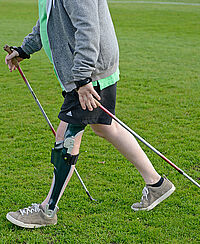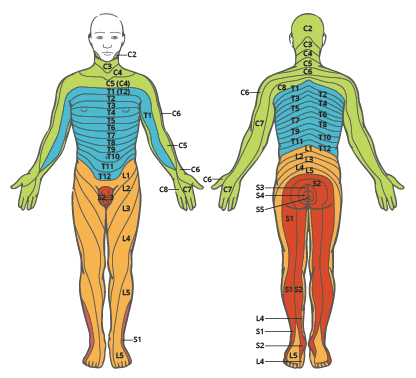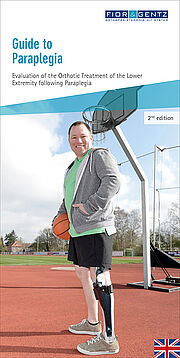Orthosis Instead of Wheelchair in case of Paraplegia

Paraplegia as well as spina bifida (myelomeningocele) are spinal cord injuries. In both cases, there is a mechanical injury to the spinal cord cross section. But while spina bifida is congenital, paraplegia is caused by accidents or otherwise. The nerve tissue running in the vertebral canal is completely or partially interrupted by the injury, resulting in the paralysis of the muscles or organs connected to the nerves. Which body functions specifically fail depends on the height up to which this cross section is still fully intact.
Being diagnosed with paraplegia does not necessarily mean that one needs a wheelchair. Depending on the muscle groups that are still functional, unassisted walking may be achieved with an orthosis. For this purpose, the orthotist must perform a detailed physical examination and configure the required orthosis with the determined patient data.
Which Patients Benefit from the Use of an Orthosis?
With the help of the ASIA classification, the neurological level can be determined. Thus, the muscles that are still controlled by the associated nerves are identified. (More information on the ASIA classification can be found in the section “General Information on Paraplegia”.) In general, one can assume that patients with lumbar and sacral lesions (from T12 downwards) benefit from an orthosis. The higher the lesion is located, the more stability the orthosis must provide. In patients with incomplete paraplegia, orthoses may even be suitable for lesion heights above T12.
When Does the Training with the Orthosis Start?
The orthosis should be provided in the so-called intermediate phase (2–26 weeks after the incident). During this phase, the orthosis also helps the patient to get up from the hospital bed independently or with support and to make their first attempts to stand. A supported and dynamic stance is an important prerequisite for the subsequent gait training.

Treatment Concept: Orthosis following Paraplegia
In our “Guide to Spinal Cord Injuries – Evaluation of the Orthotic Treatment Options of the Lower Extremity following Paraplegia” you will find a detailed concept for the treatment with an orthosis following paraplegia.
You can download the Guide to Spinal Cord Injuries free of charge here. Upon request, we will gladly send you a print copy. Please contact our In-house Customer Service at info(at)fior-gentz.de or +49 4131 24445-0.
You will find an overview of the different system joints in the knee and ankle area here. The most important functions of the respective system joint are explained in the corresponding product description.
In our User Stories and Videos you get to know patients who are already being treated with an orthosis. You can find the section on patients with paraplegia here.
General Information on Paraplegia
Which Body Parts are Affected by Paraplegia?
Spinal cord injuries are divided into complete and incomplete paraplegia, among others. They appear as paraplegia (only the legs are affected) or quadriplegia (both arms and both legs are affected).
What Are the Causes of Paraplegia?
Broadly speaking, the causes of paraplegia can be divided into traumatic (accidents) and non-traumatic causes. While traumatic causes predominate in young people, non-traumatic causes increase with age.
Traumatic causes include all types of accidents (e.g. traffic, work and sport accidents) as well as falls and the effects of violence inflicted by strangers or oneself (suicide attempts). Among the non-traumatic causes for paraplegia are congenital malformations, tumours, infections, inflammations and poisonings.
Are the Affected Body Functions Irretrievably Lost?
Reconstruction Processes after the Accident: the time immediately after the accident is defined by countless biological reconstruction processes in the affected area of the spine. Within the framework of these reconstruction processes, a spontaneous improvement of the damaged body functions can still occur up to one year after the accident.
Starting Time of Neurorehabilitation: the body has the capacity to form new nerve connections through motor impulses. Therefore, during the phase of the reconstruction processes described above, a growth of the spinal cord can be triggered by appropriate neurorehabilitation. It is important, however, that the therapy starts as early as possible in order to benefit from these reconstruction processes.
Type of Paraplegia: it makes a big difference whether the patient suffers from complete or incomplete paraplegia. Particularly in the case of incomplete paraplegia, there is a good chance of improving the damaged body functions. Furthermore, this prognosis is positively influenced by an early therapy start. In the case of complete paraplegia, the chances are fairly low in this respect, even though there can always be minor improvements.
What Is the ASIA Classification?
A term that is often used in connection with spinal cord injuries is the ASIA classification, or more precisely, the ASIA Impairment Scale (AIS). ASIA is the acronym for American Spinal Injury Association and refers to the North American society for the treatment, education and research in the field of paraplegia.
The AIS describes a structured approach for determining the level and extent of injury: in the first step, the lesion height is determined by identifying the spinal segment where neither motor nor sensory deficits occur (the so-called neurological level). For this purpose, the motor level is determined via the strength level of defined key muscles and the sensitive level at defined key points of the skin (at so-called dermatomes) by means of light touch and a pinprick test. The sensitivity at these key points provides information about the spinal level of the sensory supply. According to the AIS, spinal cord injuries are divided into four areas based on their level:
- cervical lesions (C1–C8): injury at the cervical spine level
- thoracic lesions (T1–T12): injury at the thoracic spine level
- lumbar lesions (L1–L5): injury at the lumbar spine level
- sacral lesions (S1–S5): injury at the sacrum level

In the next step, a specific evaluation key is used to assess whether the paraplegia is complete (ASIA A) or incomplete (ASIA B‑D):
A = Complete: no sensory or motor function remains in sacral segments S4–S5.
B = Incomplete: sensory but no motor function remains below the neurological level including sacral segments S4/S5.
C = Incomplete: motor function remains below the neurological level and the majority of the key muscles have a strength level of less than 3 (according to Janda).
D = Incomplete: motor function remains below the neurological level and the majority of the key muscles have a strength level greater than or equal to 3 (according to Janda).
E = Normal: sensory and motor functions are normal.

